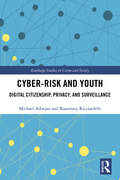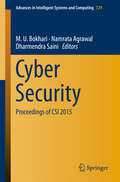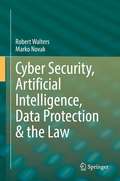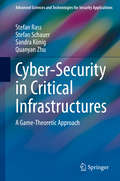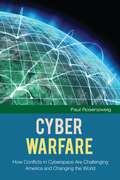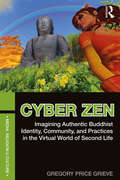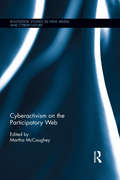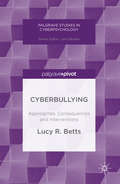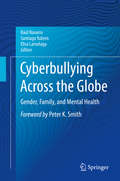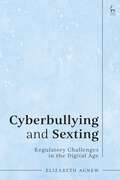- Table View
- List View
Cyber-risk and Youth: Digital Citizenship, Privacy and Surveillance (Routledge Studies in Crime and Society)
by Michael C Adorjan Rosemary RicciardelliCyber-risks are moving targets and societal responses to combat cyber-victimization are often met by the distrust of young people. Drawing on original research, this book explores how young people define, perceive, and experience cyber-risks, how they respond to both the messages they are receiving from society regarding their safety online, and the various strategies and practices employed by society in regulating their online access and activities. This book complements existing quantitative examinations of cyberbullying assessing its extent and frequency, but also aims to critique and extend knowledge of how cyber-risks such as cyberbullying are perceived and responded to. Following a discussion of their methodology and their experiences of conducting research with teens, the authors discuss the social network services that teens are using and what they find appealing about them, and address teens’ experiences with and views towards parental and school-based surveillance. The authors then turn directly to areas of concern expressed by their participants, such as relational aggression, cyberhacking, privacy, and privacy management, as well as sexting. The authors conclude by making recommendations for policy makers, educators and teens – not only by drawing from their own theoretical and sociological interpretations of their findings, but also from the responses and recommendations given by their participants about going online and tackling cyber-risk. One of the first texts to explore how young people respond to attempts to regulate online activity, this book will be key reading for those involved in research and study surrounding youth crime, cybercrime, youth culture, media and crime, and victimology – and will inform those interested in addressing youth safety online how to best approach what is often perceived as a sensitive and volatile social problem.
Cyber Security: Proceedings of CSI 2015 (Advances in Intelligent Systems and Computing #729)
by M. U. Bokhari Namrata Agrawal Dharmendra SainiThis book comprises select proceedings of the annual convention of the Computer Society of India. Divided into 10 topical volumes, the proceedings present papers on state-of-the-art research, surveys, and succinct reviews. The volume covers diverse topics ranging from information security to cryptography and from encryption to intrusion detection. This book focuses on Cyber Security. It aims at informing the readers about the technology in general and the internet in particular. The book uncovers the various nuances of information security, cyber security and its various dimensions. This book also covers latest security trends, ways to combat cyber threats including the detection and mitigation of security threats and risks. The contents of this book will prove useful to professionals and researchers alike.
Cyber Security: Critical Infrastructure Protection (Computational Methods in Applied Sciences #56)
by Martti Lehto Pekka NeittaanmäkiThis book focus on critical infrastructure protection. The chapters present detailed analysis of the issues and challenges in cyberspace and provide novel solutions in various aspects. The first part of the book focus on digital society, addressing critical infrastructure and different forms of the digitalization, strategic focus on cyber security, legal aspects on cyber security, citizen in digital society, and cyber security training. The second part focus on the critical infrastructure protection in different areas of the critical infrastructure. The chapters cover the cybersecurity situation awareness, aviation and air traffic control, cyber security in smart societies and cities, cyber security in smart buildings, maritime cyber security, cyber security in energy systems, and cyber security in healthcare. The third part presents the impact of new technologies upon cyber capability building as well as new challenges brought about by new technologies. These new technologies are among others are quantum technology, firmware and wireless technologies, malware analysis, virtualization.
Cyber Security and Social Media Applications (Lecture Notes in Social Networks)
by Sibel Tarıyan Özyer Buket KayaThis book offers an excellent source of knowledge for readers who are interested in keeping up with the developments in the field of cyber security and social media analysis. It covers the possibility of using augmented reality to monitor cyber security feeds in a multitasking environment. It describes a real-time scheduled security scanner. E-commerce concept labeling is tackled by introducing a lightweight global taxonomy induction system. Blogsphere analytics and online video narratives and networks are explored. The effect of global and local network structure, credibility based prevention of fake news dissemination, and detection of trending topics and influence from social media are investigated.This book helps the reader in developing their own perspective about how to deal with cyber security and how to benefit from the development in technology to tackle cyber security issues. The reader of this book will realize how to use various machine learning techniques for tackling various applications involving social medial analysis.
Cyber Security, Artificial Intelligence, Data Protection & the Law
by Robert Walters Marko NovakThis book provides a comparison and practical guide of the data protection laws of Canada, China (Hong Kong, Macau, Taiwan), Laos, Philippines, South Korea, United States and Vietnam. The book builds on the first book Data Protection Law. A Comparative Analysis of Asia-Pacific and European Approaches, Robert Walters, Leon Trakman, Bruno Zeller. As the world comes to terms with Artificial Intelligence (AI), which now pervades the daily lives of everyone. For instance, our smart or Iphone, and smart home technology (robots, televisions, fridges and toys) access our personal data at an unprecedented level. Therefore, the security of that data is increasingly more vulnerable and can be compromised. This book examines the interface of cyber security, AI and data protection. It highlights and recommends that regulators and governments need to undertake wider research and law reform to ensure the most vulnerable in the community have their personal data protected adequately, while balancing the future benefits of the digital economy.
Cyber-Security in Critical Infrastructures: A Game-Theoretic Approach (Advanced Sciences and Technologies for Security Applications)
by Quanyan Zhu Stefan Rass Stefan Schauer Sandra KönigThis book presents a compendium of selected game- and decision-theoretic models to achieve and assess the security of critical infrastructures. Given contemporary reports on security incidents of various kinds, we can see a paradigm shift to attacks of an increasingly heterogeneous nature, combining different techniques into what we know as an advanced persistent threat. Security precautions must match these diverse threat patterns in an equally diverse manner; in response, this book provides a wealth of techniques for protection and mitigation. Much traditional security research has a narrow focus on specific attack scenarios or applications, and strives to make an attack “practically impossible.” A more recent approach to security views it as a scenario in which the cost of an attack exceeds the potential reward. This does not rule out the possibility of an attack but minimizes its likelihood to the least possible risk. The book follows this economic definition of security, offering a management scientific view that seeks a balance between security investments and their resulting benefits. It focuses on optimization of resources in light of threats such as terrorism and advanced persistent threats. Drawing on the authors’ experience and inspired by real case studies, the book provides a systematic approach to critical infrastructure security and resilience. Presenting a mixture of theoretical work and practical success stories, the book is chiefly intended for students and practitioners seeking an introduction to game- and decision-theoretic techniques for security. The required mathematical concepts are self-contained, rigorously introduced, and illustrated by case studies. The book also provides software tools that help guide readers in the practical use of the scientific models and computational frameworks.
Cyber Security: Issues and Current Trends (Studies in Computational Intelligence #995)
by Nitul Dutta Nilesh Jadav Sudeep Tanwar Hiren Kumar Sarma Emil PricopThis book presents various areas related to cybersecurity. Different techniques and tools used by cyberattackers to exploit a system are thoroughly discussed and analyzed in their respective chapters. The content of the book provides an intuition of various issues and challenges of cybersecurity that can help readers to understand and have awareness about it. It starts with a very basic introduction of security, its varied domains, and its implications in any working organization; moreover, it will talk about the risk factor of various attacks and threats. The concept of privacy and anonymity has been taken into consideration in consecutive chapters. Various topics including, The Onion Router (TOR) and other anonymous services, are precisely discussed with a practical approach. Further, chapters to learn the importance of preventive measures such as intrusion detection system (IDS) are also covered. Due to the existence of severe cyberattacks, digital forensics is a must for investigating the crime and to take precautionary measures for the future occurrence of such attacks. A detailed description of cyberinvestigation is covered in a chapter to get readers acquainted with the need and demands. This chapter deals with evidence collection from the victim's device and the system that has importance in the context of an investigation. Content covered in all chapters is foremost and reported in the current trends in several journals and cybertalks. The proposed book is helpful for any reader who is using a computer or any such electronic gadget in their daily routine. The content of the book is prepared to work as a resource to any undergraduate and graduate-level student to get aware about the concept of cybersecurity, various cyberattacks, and threats in the security. In addition to that, it aimed at assisting researchers and developers to build a strong foundation for security provisioning in any newer technology which they are developing.
Cyber-Sicherheit (Studien zur Inneren Sicherheit #18)
by Hans-Jürgen Lange Astrid BötticherDie technikvermittelte Kommunikation wird immer wichtiger. Diese Entwicklung wurde zum Anlass genommen, die diversen Aspekte der Cyber-Sicherheit aus disziplinübergreifender Perspektive zu untersuchen. Der strukturelle Wandel, der sich aus den Implikationen der Informationsgesellschaft ergibt, die Handlungsgrenzen der Institutionen, Organisationen und verschiedenen Akteure der Gesellschaft sowie Fragen der Cybersicherheit sind die Themen, die diese Publikation in einem interdisziplinären Zusammenspiel aufgreift.
Cyber Technological Paradigms and Threat Landscape in India
by Ramnath ReghunadhanThe book deals with technological governance of cyberspace and threat landscape, with a special focus on the Indian context. It provides a historical and chronological understanding of cyber threats across the world, and their impact on the nation-states. It places the cyber technological paradigms and platforms in various theoretical frameworks. The core section of the book deals with the cyber technological paradigms, i.e., governance, policing, and diplomacy in Digital India. The scenario of artificial intelligence (AI) in India is also dealt with, comparing AI in India with those of international actors. The book analyses in detail, the overall structural and institutional frameworks, entailing the need to leap towards what is considered as Reimagining India. It provides policy recommendations and suggestions on improving various actions, initiatives and resilience related taken in order to deal with the chaotic features of cyber technological threat landscape in India.
Cyber-War: The Anatomy of the Global Security Threat
by J. RichardsCyber-War provides a critical assessment of current debates around the likelihood and impact of cyber warfare. Approaching the subject from a socio-political angle, it argues that destructive cyber war has not yet been seen, but could be a feature of future conflict.
Cyber Warfare: How Conflicts in Cyberspace Are Challenging America and Changing the World (The Changing Face of War)
by Paul RosenzweigThis book provides an up-to-date, accessible guide to the growing threats in cyberspace that affects everyone from private individuals to businesses to national governments.Cyber Warfare: How Conflicts In Cyberspace Are Challenging America and Changing The World is a comprehensive and highly topical one-stop source for cyber conflict issues that provides scholarly treatment of the subject in a readable format. The book provides a level-headed, concrete analytical foundation for thinking about cybersecurity law and policy questions, covering the entire range of cyber issues in the 21st century, including topics such as malicious software, encryption, hardware intrusions, privacy and civil liberties concerns, and other interesting aspects of the problem.In Part I, the author describes the nature of cyber threats, including the threat of cyber warfare. Part II describes the policies and practices currently in place, while Part III proposes optimal responses to the challenges we face. The work should be considered essential reading for national and homeland security professionals as well as students and lay readers wanting to understand of the scope of our shared cybersecurity problem.
Cyber Warfare: How Conflicts in Cyberspace Are Challenging America and Changing the World (The Changing Face of War)
by Paul RosenzweigThis book provides an up-to-date, accessible guide to the growing threats in cyberspace that affects everyone from private individuals to businesses to national governments.Cyber Warfare: How Conflicts In Cyberspace Are Challenging America and Changing The World is a comprehensive and highly topical one-stop source for cyber conflict issues that provides scholarly treatment of the subject in a readable format. The book provides a level-headed, concrete analytical foundation for thinking about cybersecurity law and policy questions, covering the entire range of cyber issues in the 21st century, including topics such as malicious software, encryption, hardware intrusions, privacy and civil liberties concerns, and other interesting aspects of the problem.In Part I, the author describes the nature of cyber threats, including the threat of cyber warfare. Part II describes the policies and practices currently in place, while Part III proposes optimal responses to the challenges we face. The work should be considered essential reading for national and homeland security professionals as well as students and lay readers wanting to understand of the scope of our shared cybersecurity problem.
Cyber Weaponry: Issues and Implications of Digital Arms (Advanced Sciences and Technologies for Security Applications)
by Henry PrunckunThere is little doubt that cyber-space has become the battle space for confrontations. However, to conduct cyber operations, a new armory of weapons needs to be employed. No matter how many, or how sophisticated an aggressor’s kinetic weapons are, they are useless in cyber-space. This book looks at the milieu of the cyber weapons industry, as well as the belligerents who use cyber weapons. It discusses what distinguishes these hardware devices and software programs from computer science in general. It does this by focusing on specific aspects of the topic—contextual issues of why cyber-space is the new battleground, defensive cyber weapons, offensive cyber weapons, dual-use weapons, and the implications these weapons systems have for practice. Contrary to popular opinion, the use of cyber weapons is not limited to nation states; though this is where the bulk of news reporting focuses. The reality is that there isn’t a sector of the political-economy that is immune to cyber skirmishes. So, this book looks at cyber weapons not only by national security agencies and the military, but also by law enforcement, and the business sector—the latter includes administrations termed non-government organisations (NGOs). This book offers study material suitable for a wide-ranging audience—students, professionals, researchers, policy officers, and ICT specialists.
Cyber Zen: Imagining Authentic Buddhist Identity, Community, and Practices in the Virtual World of Second Life (Media, Religion and Culture)
by Gregory Price GrieveCyber Zen ethnographically explores Buddhist practices in the online virtual world of Second Life. Does typing at a keyboard and moving avatars around the screen, however, count as real Buddhism? If authentic practices must mimic the actual world, then Second Life Buddhism does not. In fact, a critical investigation reveals that online Buddhist practices have at best only a family resemblance to canonical Asian traditions and owe much of their methods to the late twentieth-century field of cybernetics. If, however, they are judged existentially, by how they enable users to respond to the suffering generated by living in a highly mediated consumer society, then Second Life Buddhism consists of authentic spiritual practices. Cyber Zen explores how Second Life Buddhist enthusiasts form communities, identities, locations, and practices that are both products of and authentic responses to contemporary Network Consumer Society. Gregory Price Grieve illustrates that to some extent all religion has always been virtual and gives a glimpse of possible future alternative forms of religion.
Cyber Zen: Imagining Authentic Buddhist Identity, Community, and Practices in the Virtual World of Second Life (Media, Religion and Culture)
by Gregory Price GrieveCyber Zen ethnographically explores Buddhist practices in the online virtual world of Second Life. Does typing at a keyboard and moving avatars around the screen, however, count as real Buddhism? If authentic practices must mimic the actual world, then Second Life Buddhism does not. In fact, a critical investigation reveals that online Buddhist practices have at best only a family resemblance to canonical Asian traditions and owe much of their methods to the late twentieth-century field of cybernetics. If, however, they are judged existentially, by how they enable users to respond to the suffering generated by living in a highly mediated consumer society, then Second Life Buddhism consists of authentic spiritual practices. Cyber Zen explores how Second Life Buddhist enthusiasts form communities, identities, locations, and practices that are both products of and authentic responses to contemporary Network Consumer Society. Gregory Price Grieve illustrates that to some extent all religion has always been virtual and gives a glimpse of possible future alternative forms of religion.
Cyberactivism: Online Activism in Theory and Practice
by Martha Mccaughey Michael D. AyersCyberactivism is a timely collection of essays examining the growing importance of online activism. The contributors show how online activists have not only incorporated recent technology as a tool for change, but also how they have changed the meaning of activism, what community means, and how they conceive of collective identity and democratic change. Topics addressed range from the Zapatista movement's use of the web to promote their cause globally to the establishment of alternative media sources like indymedia.org to the direct action of "hacktivists" who disrupt commercial computer networks. Cyberactivism is essential reading for anyone interested in understanding the impact of the Internet on politics today.
Cyberactivism: Online Activism in Theory and Practice (Routledge Studies In New Media And Cyberculture Ser.)
by Martha McCaughey Michael D. AyersCyberactivism is a timely collection of essays examining the growing importance of online activism. The contributors show how online activists have not only incorporated recent technology as a tool for change, but also how they have changed the meaning of activism, what community means, and how they conceive of collective identity and democratic change. Topics addressed range from the Zapatista movement's use of the web to promote their cause globally to the establishment of alternative media sources like indymedia.org to the direct action of "hacktivists" who disrupt commercial computer networks. Cyberactivism is essential reading for anyone interested in understanding the impact of the Internet on politics today.
Cyberactivism and Citizen Journalism in Egypt: Digital Dissidence and Political Change (Information Technology and Global Governance)
by Courtney C. RadschThis compelling book explores how Egyptian bloggers used citizen journalism and cyberactivism to chip away at the state’s monopoly on information and recalibrate the power dynamics between an authoritarian regime and its citizens. When the Arab uprisings broke out in early 2011 and ousted entrenched leaders across the region, social media and the Internet were widely credited with playing a role, particularly when the Egyptian government shut down the Internet and mobile phone networks in an attempt to stave off the unrest there. But what these reports missed were the years of grassroots organizing, digital activism, and political awareness-raising that laid the groundwork for this revolutionary change. Radsch argues that Egyptian bloggers created new social movements using blogging and social media, often at significant personal risk, so that less than a decade after the information revolution came to Egypt they successfully mobilized the overthrow of the state and its president.
Cyberactivism on the Participatory Web (Routledge Studies in New Media and Cyberculture)
by Martha McCaugheyCyberactivism already has a rich history, but over the past decade the participatory web—with its de-centralized information/media sharing, portability, storage capacity, and user-generated content—has reshaped political and social change. Cyberactivism on the Participatory Web examines the impact of these new technologies on political organizing and protest across the political spectrum, from the Arab Spring to artists to far-right groups. Linking new information and communication technologies to possibilities for solidarity and action—as well as surveillance and control—in a context of global capital flow, war, and environmental crisis, the contributors to this volume provide nuanced analyses of the dramatic transformations in media, citizenship, and social movements taking place today.
Cyberactivism on the Participatory Web (Routledge Studies in New Media and Cyberculture)
by Martha McCaugheyCyberactivism already has a rich history, but over the past decade the participatory web—with its de-centralized information/media sharing, portability, storage capacity, and user-generated content—has reshaped political and social change. Cyberactivism on the Participatory Web examines the impact of these new technologies on political organizing and protest across the political spectrum, from the Arab Spring to artists to far-right groups. Linking new information and communication technologies to possibilities for solidarity and action—as well as surveillance and control—in a context of global capital flow, war, and environmental crisis, the contributors to this volume provide nuanced analyses of the dramatic transformations in media, citizenship, and social movements taking place today.
Cyberbullies, Cyberactivists, Cyberpredators: Film, TV, and Internet Stereotypes
by Lauren RosewarneWritten by an expert in media, popular culture, gender, and sexuality, this book surveys the common archetypes of Internet users—from geeks, nerds, and gamers to hackers, scammers, and predators—and assesses what these stereotypes reveal about our culture's attitudes regarding gender, technology, intimacy, and identity.The Internet has enabled an exponentially larger number of people—individuals who are members of numerous and vastly different subgroups—to be exposed to one other. As a result, instead of the simple "jocks versus geeks" paradigm of previous eras, our society now has more detailed stereotypes of the undesirable, the under-the-radar, and the ostracized: cyberpervs, neckbeards, goths, tech nerds, and anyone with a non-heterosexual identity. Each chapter of this book explores a different stereotype of the Internet user, with key themes—such as gender, technophobia, and sexuality—explored with regard to that specific characterization of online users.Author Lauren Rosewarne, PhD, supplies a highly interdisciplinary perspective that draws on research and theories from a range of fields—psychology, sociology, and communications studies as well as feminist theory, film theory, political science, and philosophy—to analyze what these stereotypes mean in the context of broader social and cultural issues. From cyberbullies to chronically masturbating porn addicts to desperate online-daters, readers will see the paradox in popular culture's message: that while Internet use is universal, actual Internet users are somehow subpar—less desirable, less cool, less friendly—than everybody else.
Cyberbullies, Cyberactivists, Cyberpredators: Film, TV, and Internet Stereotypes
by Lauren RosewarneWritten by an expert in media, popular culture, gender, and sexuality, this book surveys the common archetypes of Internet users—from geeks, nerds, and gamers to hackers, scammers, and predators—and assesses what these stereotypes reveal about our culture's attitudes regarding gender, technology, intimacy, and identity.The Internet has enabled an exponentially larger number of people—individuals who are members of numerous and vastly different subgroups—to be exposed to one other. As a result, instead of the simple "jocks versus geeks" paradigm of previous eras, our society now has more detailed stereotypes of the undesirable, the under-the-radar, and the ostracized: cyberpervs, neckbeards, goths, tech nerds, and anyone with a non-heterosexual identity. Each chapter of this book explores a different stereotype of the Internet user, with key themes—such as gender, technophobia, and sexuality—explored with regard to that specific characterization of online users.Author Lauren Rosewarne, PhD, supplies a highly interdisciplinary perspective that draws on research and theories from a range of fields—psychology, sociology, and communications studies as well as feminist theory, film theory, political science, and philosophy—to analyze what these stereotypes mean in the context of broader social and cultural issues. From cyberbullies to chronically masturbating porn addicts to desperate online-daters, readers will see the paradox in popular culture's message: that while Internet use is universal, actual Internet users are somehow subpar—less desirable, less cool, less friendly—than everybody else.
Cyberbullying: Approaches, Consequences and Interventions (Palgrave Studies in Cyberpsychology)
by Lucy R. BettsDrawing on research evidence and media coverage, this book explores a number of key debates surrounding cyberbullying. The increasing digitization of society affords many benefits; however, some of these benefits are offset by more adverse consequences. Cyberbullying represents one of the adverse consequences of technology use, which has become a topic of increasing societal concern. Betts adopts a critical stance to exploring issues around the definition of cyberbullying, the unique nature of cyberbullying compared to other forms of bullying, the variation in the reported prevalence rates of cyberbullying, the consequences of involvement in cyberbullying, and the steps that can be taken to tackle cyberbullying.
Cyberbullying Across the Globe: Gender, Family, and Mental Health
by Raúl Navarro Santiago Yubero Elisa LarrañagaThis book provides a much-needed analysis of the current research in the global epidemic of electronic bullying. Scholars and professionals from the Americas, Europe, and Asia offer data, insights, and solutions, acknowledging both the social psychology and technological contexts underlying cyberbullying phenomena. Contributors address questions that are just beginning to emerge as well as longstanding issues concerning family and gender dynamics, and provide evidence-based prevention and intervention strategies for school and home. The global nature of the book reflects not only the scope and severity of cyberbullying, but also the tenacity of efforts to control and eradicate the problem. Included in the coverage: • Gender issues and cyberbullying in children and adolescents: from gender differences to gender identity measures. • Family relationships and cyberbullying.• Examining the incremental impact of cyberbullying on outcomes over and above traditional bullying in North America.• A review of cyberbullying and education issues in Latin America.• Cyberbullying prevention from child and youth literature.• Cyberbullying and restorative justice. Cyberbullying across the Globe is an essential resource for researchers, graduate students, and other professionals in child and school psychology, public health, social work and counseling, educational policy, and family advocacy.
Cyberbullying and Sexting: Regulatory Challenges in the Digital Age
by Dr Elizabeth AgnewDrawing on two empirical studies and influential theoretical frameworks, this book provides a critical overview of the key regulatory challenges concerning cyberbullying and sexting behaviours among young people (persons under 18 years).The author explores issues such as conceptualising the behaviours, examining the prevailing presence of sexism, myths and stereotypes surrounding gender roles and identity, and the limitations of criminal law as an effective regulatory tool. In doing so, identifying peer-based sexting behaviours as part of a continuum of sexual behaviour is promoted alongside the need to consider interventions beyond the legal landscape and in line with the United Nations Convention on the Rights of the Child. In the main, priority is given to non-legal responses and the need for more effective and comprehensive gender-sensitive education programmes. The book therefore provides a more developed conceptual understanding of sexting and cyberbullying behaviours among young people.
